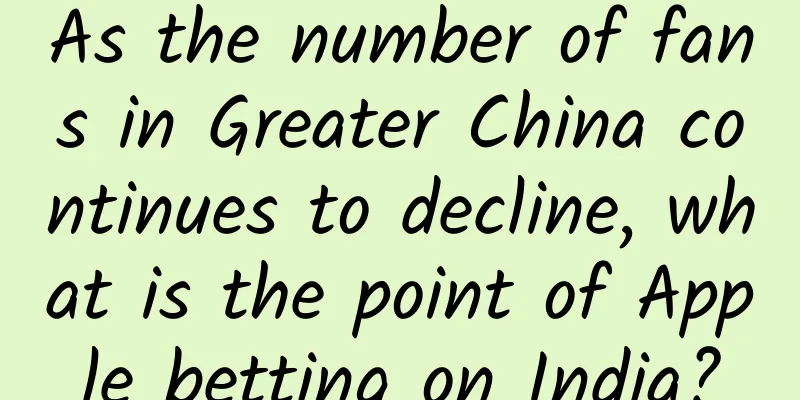As the number of fans in Greater China continues to decline, what is the point of Apple betting on India?

|
Recently, Apple released its first quarter financial report for 2017, which was higher than expected. From the perspective of revenue and net profit, it seems to be still prosperous, but it is still weak. In particular, the Greater China region has been declining for four consecutive quarters, which has made its survival in overseas markets face unprecedented challenges. The industry generally believes that the reasons for this problem are that Apple's innovative and subversive genes are gradually being worn away, and the external environment is full of strong competitors. At this time, the importance of the Indian market to Apple is self-evident. It is reported that Apple has obtained the consent of the state of Karnataka to build an iPhone manufacturing plant in the Bangalore Technology Park in India, which means that Cook is still crawling in this huge market despite the political pressure and moral kidnapping of Trump. However, the game of interests at the negotiation table is still going on. Can Apple win this turnaround battle by building a factory in India alone? What is the bottom line of the Indian government's policy tolerance towards Apple? They seem to need each other, but Apple's needs are more urgent As for the combination of the two, Apple's demand for the Indian market is obviously more urgent at present, which is closely related to its current situation, especially the setbacks last year, which fully exposed the company's development bottlenecks, namely innovation, quality and strong competitors. Since the launch of iPhone 7, this phone has been questioned and ridiculed. Although it has good sales, a large part of the credit should be attributed to Samsung's battery supplier. Even so, many people still ridicule Apple, saying that it is disappointing that it has only achieved this little success when Samsung is exploding. Even former Apple engineer Bob Borrug complained that Cook has made Apple "boring", so even if he has made Apple the most valuable company in the world, he has not been able to maintain the brand's position as a trend leader in the smartphone field. However, this cannot be entirely attributed to Cook. The saturation of the smartphone market is not only due to the stagnation of quantity, but also the criticality of functions. The battery life, appearance, processor, etc. have reached a fairly perfect level, and the new performance improvement faces technical shackles, which limits the innovation level of any mobile phone manufacturer, including Apple. Perhaps because of the legend of Jobs, consumers have higher expectations of Apple than other companies. Once the reality cannot meet this expectation, it is common for loyalty to decline. However, the fan loss in Greater China is also due to product quality issues and Apple's attitude towards handling the issue. A detailed count of Apple's product accidents last year shows that there were endless phenomena such as explosions during charging, untimely shutdowns, fuzzy sounds, freezing and flashbacks. There were also cases of senior Apple fans smashing iPhone 7s in mobile phone stores. These product defects are very different from Apple's focus and professional positioning of only making one mobile phone. In addition, the evasive attitude of after-sales service or the non-positive solution method have made Chinese people fed up with Apple's arrogance, so they can choose new phones more rationally. In addition to itself, the rapid rise of competitors has also put great pressure on Apple. In addition to Samsung, Huawei, OPPO and Vivo are gradually becoming strong competitors in Apple's domestic and overseas markets with their own advantages, especially in the most critical Indian market. In summary, the combined effect of these three has reduced Apple's market share and brand influence, so India, a field with a large population base and an uncertain pattern, has become a must-fight place. India hopes to use Apple to enhance the influence of Indian manufacturing Of course, the Indian government's intention to cooperate with Apple is also obvious. After all, this is related to the promotion and improvement of "Made in India". India's software outsourcing industry is already world-renowned, but in comparison, hardware manufacturing has always been unsatisfactory. Imitating the successful model of Made in China has become a realistic and feasible path, which is the original intention of "Made in India". Moreover, Modi's political proposition at the beginning of the campaign was to strive to bring more manufacturing jobs to India, so encouraging technology companies to build more factories in India is an important measure to realize this promise. However, the progress of "Make in India" is not as rapid as that of "Made in China". The specific national conditions such as political factors and religious beliefs have made the plan questionable. In particular, the continued weakness of investment, the decline in export volume, and the complex commodity tax have made it more difficult to attract foreign investment. At this time, if Apple, a world-renowned company, enters India, it will be beneficial to "Made in India". First, it can serve as a model and expand space for India to embrace international business; second, India can not only get Apple mobile phones at a lower price, but also provide jobs for Indian labor; third, it can stimulate Apple to open retail stores and increase the purchase of local parts. In addition, improving local hardware manufacturing capabilities and making full use of human resources advantages will directly contribute to the enhancement of India's macro-international strength and the improvement of the income level of its population. In short, building a factory in India is a done deal. Although many conditions have not yet been negotiated, there is no doubt that this is an important opportunity for Apple to expand in India. Apple needs India to save its continued sluggish sales, and India also needs Apple to enhance the international influence of "Made in India". Apple needs to cut its phone prices by 50% to gain an advantage in India's mid- to high-end market Due to import tariffs, middleman profits and double taxation, the price of Apple phones in India is higher than that in the United States and other places, which is tantamount to adding insult to injury for Apple, which already has no price advantage. Therefore, price will be the biggest limitation for Apple phones to sell in India. Building factories in India for assembly can not only avoid tariffs and other costs, but also help promote the localization of Apple phones, which will be an important step for Apple to expand its market in India. The question is, in Apple's style, will the price cuts happen? And given India's per capita income, how much of a cut would be needed to achieve rapid sales growth? In order to maintain the high profits of Apple mobile phones, the company has always pursued a pricing strategy of high configuration and high price. However, in view of India's specific national conditions and strategic position, Apple has had to adjust prices frequently. Of course, it mainly carried out timely price cuts. For example, the price of Apple 5s dropped from 44,500 rupees (about 4,285 yuan) to 24,999 rupees (about 2,407 yuan) at the end of 2015, which is almost half of what it was three months ago. In other words, every year when Apple releases a new phone, the only thing that most Indians are happy about and concerned about is that it will drive down the price of old phones. So in order to maintain and promote the development of Apple phones in the Indian market, Apple must do its best to reasonably reduce prices. However, even if the price is reduced, it is difficult to reach the purchasing power of Indians, and it is even questionable whether it can be reduced to the price in the United States or the price of the domestic version. According to a report by Deutsche Bank, India is one of the most expensive places in the world for iPhones, with prices 31% higher than in the United States on average. Take the iPhone 7 as an example. Its starting price in India is 70,000 rupees, equivalent to 6,950 yuan, or 900 US dollars, which is about 2,000 yuan higher than the US version. This price difference also exists for older models. The price that Indian mid- to high-end smartphone consumers have to bear is more than 500 US dollars, which means that Apple phones can only gain an advantage in the mid- to high-end market if the price is reduced by about 50%, but this is basically impossible. In short, building a factory in India does not guarantee that Apple phones will drop in price significantly, which is why Apple has always insisted on selling refurbished phones in India. However, this idea is just wishful thinking at present, and from the perspective of the Indian government, it is very likely to be rejected. Apple has repeatedly asked India to agree to implement this measure, but both the authorities and ordinary people have unanimously protested. Indian Minister of Commerce and Industry Nirmala Sitharaman once said at a press conference: "We do not support any company selling used mobile phones in our country, no matter how they are certified." Apple needs time and patience to expand into India Currently, the iPhone production line has reached the final negotiation stage. Apple has requested the Indian government to make a series of concessions for iPhone manufacturing in India. In addition to granting Apple a 15-year investment tax exemption, it hopes to sell refurbished iPhones that meet mobile phone quality standards in India. During the negotiations, Apple told Indian government officials that its refurbished phone program can withstand inspection, meet environmental and quality requirements, and accept third-party supervision and verification. Although the negotiations have not yet been concluded, all parties will prevent the implementation of this proposal. First of all, the Indian government is mainly concerned about the consequences of the proliferation of refurbished machines. The official statement is that "it may become a garbage recycling station for electronic consumer products", which will affect the international image of "Made in India" and thus damage the "national honor". However, there is another deeper consideration: once Apple obtains the license, it will invest most of its investment in refurbished machines, which is much less than the investment in producing new machines, which is directly related to the issue of attracting foreign investment and improving the level of manufacturing. Secondly, some resistance comes from the opposition of competitors. Since Apple proposed to sell refurbished phones, Samsung and other local mobile phone brands in India have jointly issued strong statements against Apple's proposal. If India sets a precedent for Apple, other mobile phone manufacturers will surely make similar requests, which will make it difficult for the Indian government to do so. In short, Apple's quality assurance is insignificant in the face of national honor. Unless India is given greater benefits, it will be difficult to convince the authorities to accept it. Another contradiction at the center of the tense negotiations is that India insists that Apple purchase 30% of its components locally like other mobile phone brands, while Apple applies for a 15-year tax exemption period for the import of its components and equipment. The former is directly related to Apple's establishment of direct stores in India. As we all know, the sales channels of smartphones in India are complicated and chaotic. Online marketing is limited by local infrastructure and it will take a long time for it to work. Therefore, offline retail stores are crucial for smartphone sales. This is also the reason why Apple has not been able to increase its popularity and accumulate loyalty in India. According to some studies, nearly half of Indians do not know the Apple brand, which is unimaginable in other countries. It is an indisputable fact that the high-end positioning of Apple mobile phones is extremely inconsistent with the current development level of India. However, India is still in the transition stage from feature phones to smart phones, with a penetration rate of only 30%. For this country with a population second only to China, there is still huge room for development of mobile Internet. At this time, Apple's increased layout in India is a process of considering time and patience. Before it forms a similar popularity as in China, it may be feasible to rely on R&D centers for localized operations and accelerate channel construction. But how much time can Apple have in the Indian market surrounded by powerful competitors? As a winner of Toutiao's Qingyun Plan and Baijiahao's Bai+ Plan, the 2019 Baidu Digital Author of the Year, the Baijiahao's Most Popular Author in the Technology Field, the 2019 Sogou Technology and Culture Author, and the 2021 Baijiahao Quarterly Influential Creator, he has won many awards, including the 2013 Sohu Best Industry Media Person, the 2015 China New Media Entrepreneurship Competition Beijing Third Place, the 2015 Guangmang Experience Award, the 2015 China New Media Entrepreneurship Competition Finals Third Place, and the 2018 Baidu Dynamic Annual Powerful Celebrity. |
>>: Audi pledges to make diesel cheating investigation public
Recommend
What is Taobao Alliance? How to promote Taobao Alliance?
Taobao merchants are no longer unfamiliar with Ta...
Wudalianchi has two strings of native "Tanghulu"! If you don't believe it, take a look →
The Wudalianchi volcanic group is located in the ...
How to deploy a huge amount of Qianchuan when cold starting a new account?
This article will explain what actions need to be...
Hu Quan: Killer Applications in the Industrial 4.0 Era
In the era of Industry 4.0, from the perspective ...
Use vitamin C effervescent tablets with caution, as overdose may cause gout!
Audit expert: Shen Yingjian Director of the Nutri...
China Passenger Car Association: Analysis of the national passenger car market in September 2022
1. Review of the national passenger car market in...
Super practical dry goods: the universal formula for quickly creating good copywriting
When I was in college, my major was Chinese Langu...
8 App Rapid Development Tools That Developers Must Know
"I have a great idea, all I need is a CTO......
Kidney disease can not eat soy products? It's all a misunderstanding
Diet management is an extremely important part of...
A country has legalized marijuana! Auditory hallucinations, intellectual disabilities...soft drugs are no joke!
Experts in this article: Hu Houxiang, Chief Physi...
A project that makes money out of nothing, you can earn over ten thousand yuan a month without spending a penny!
I saw a news report these days that said a house ...
The different concepts of positions in RecyclerView can help you handle data items and user interactions more efficiently.
getAdapterPosition getAdapterPosition() is a meth...
4 Effective Strategies to Increase App User Engagement
The definition of user engagement varies from pro...
How to become a qualified information flow advertising optimizer?
In our daily work, we have all read a lot of usef...
Are you bitten by mosquitoes in winter? It's normal. Insects have their own unique ways to survive the winter.
According to common sense, insects seem unable to...









